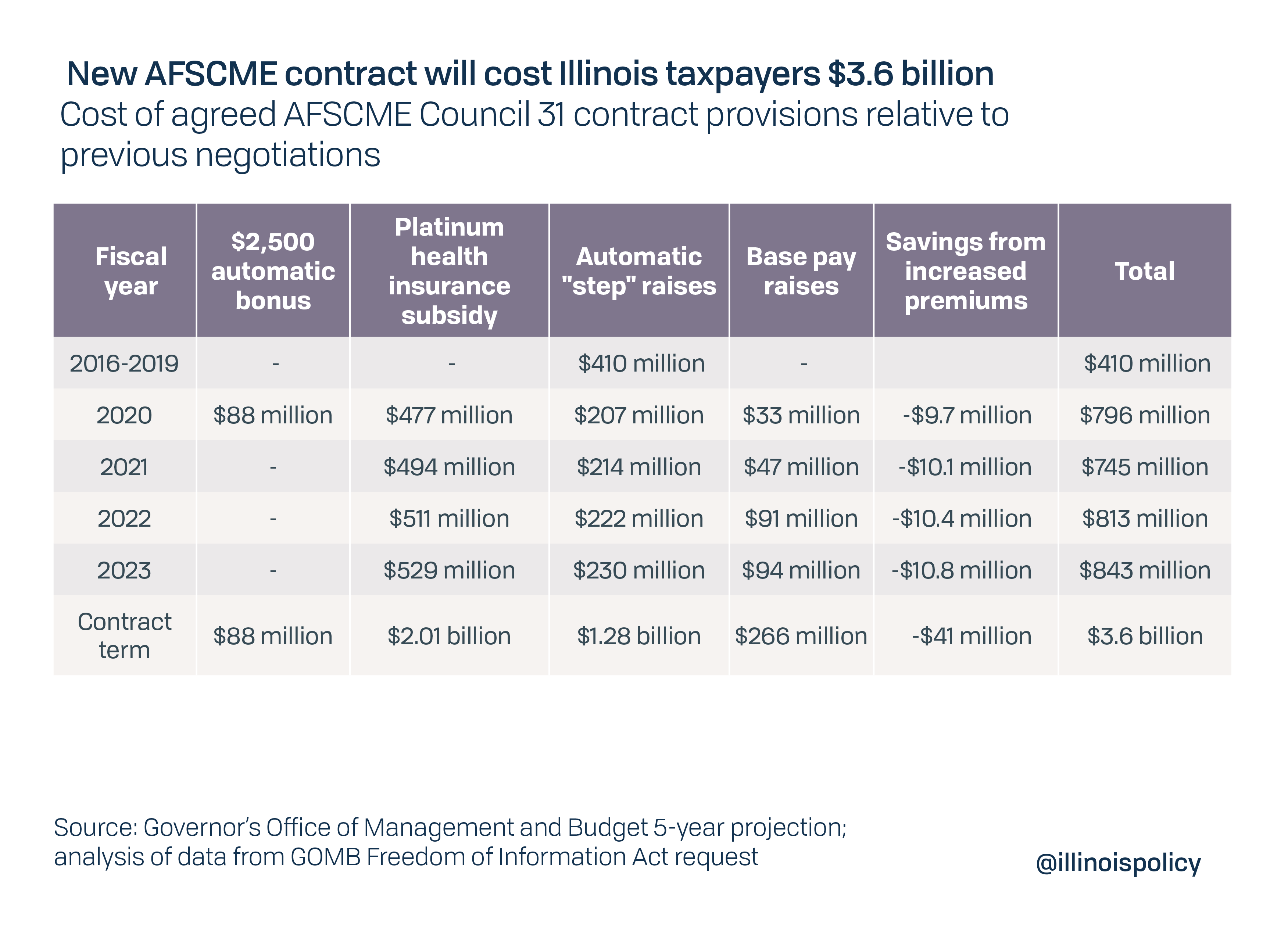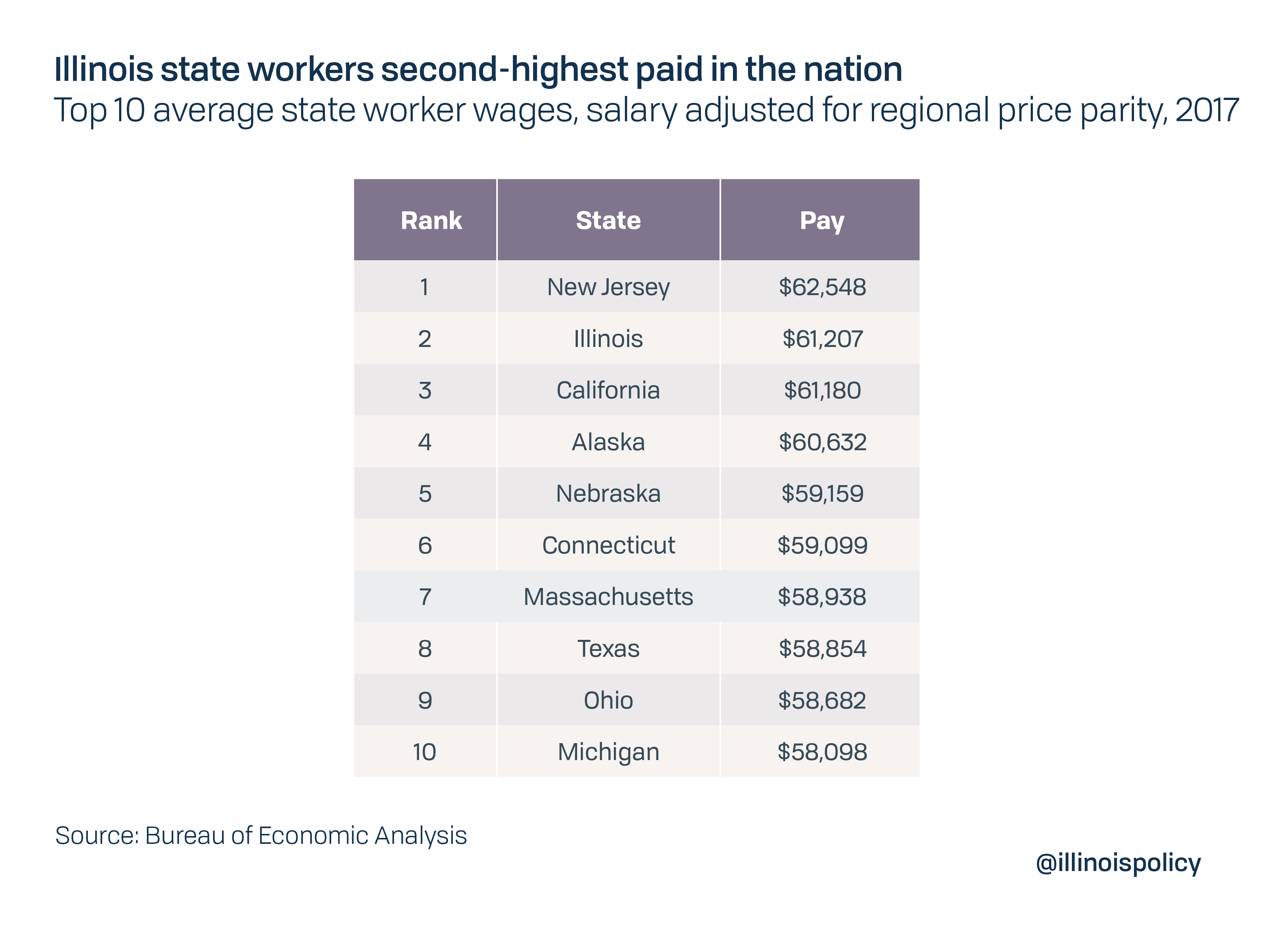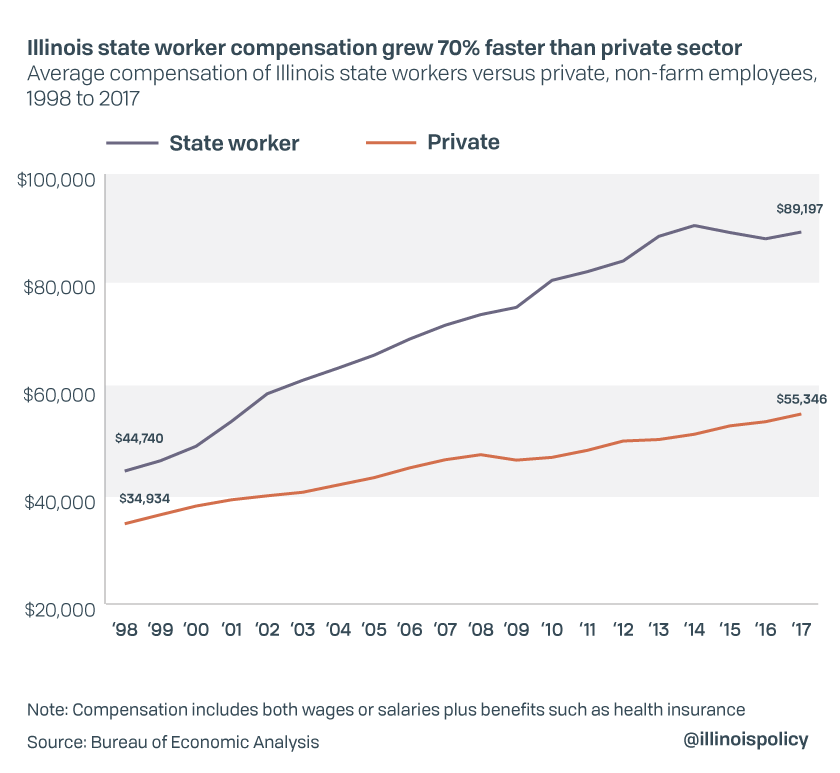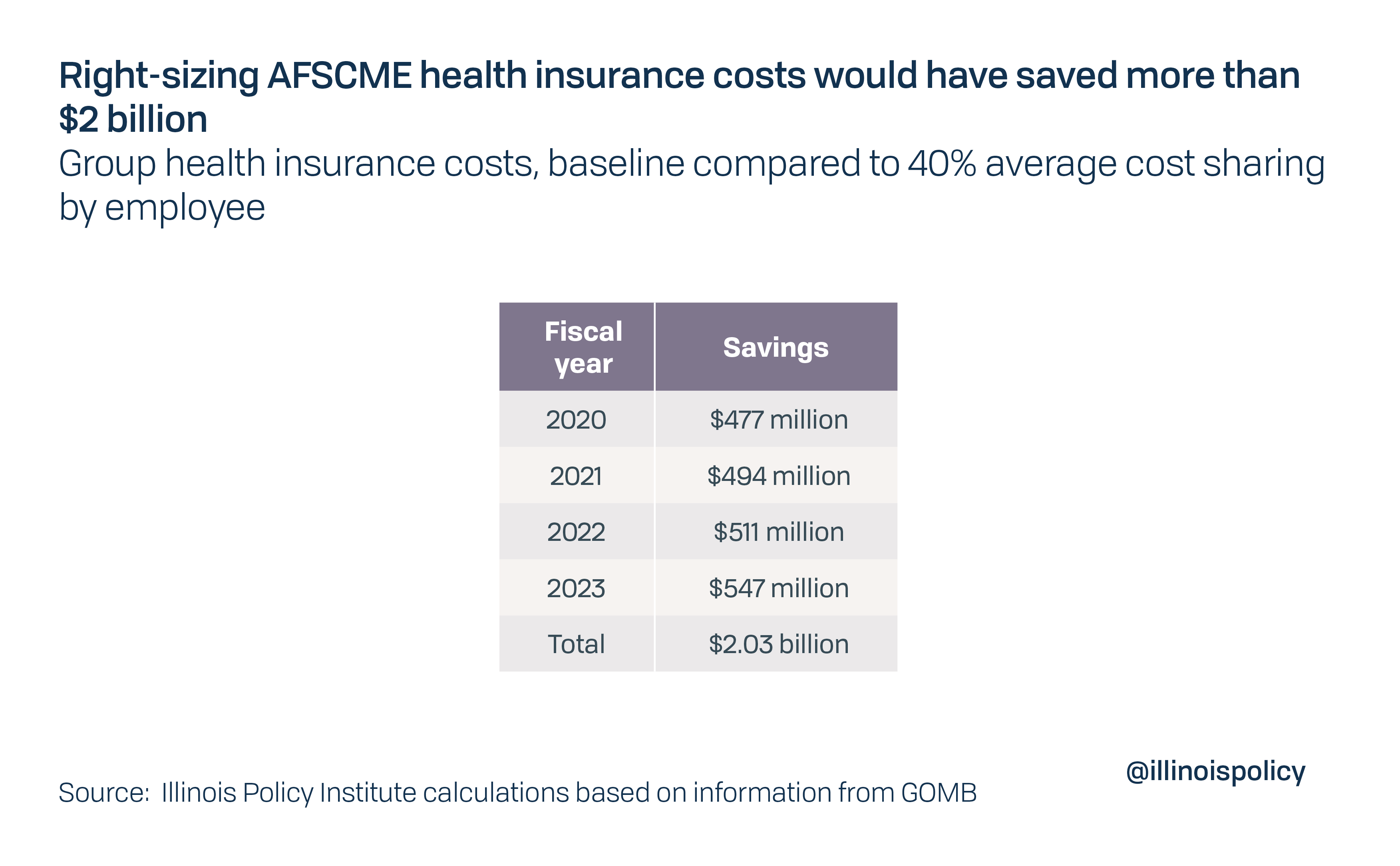Pritzker signs AFSCME deal costing taxpayers $3.6 billion more than it needed to
By continuing practices such as automatic raises and taxpayer-subsidized platinum health insurance, along with a new $2,500 bonus, the AFSCME contract will transfer more than $3.6 billion in extra compensation from taxpayers to state workers.
Illinois Gov. J.B. Pritzker signed a deal Aug. 23 with the state’s largest public employee union that offers automatic 12% raises, a $2,500 bonus and will cost state taxpayers $3.6 billion more than was necessary.
A summary of the agreement produced by the American Federation of State, County and Municipal Employees Council 31 details the $2,500-per-worker automatic bonuses, automatic raises and taxpayer-subsidized platinum health insurance benefits state workers will receive until the contract expires June 30, 2023.
The Illinois Policy Institute outlined possible savings under a fair contract in Budget Solutions 2020, a five-year fiscal plan for the state of Illinois. The new contract will cost $3.6 billion more than what taxpayers would have paid under a taxpayer-friendly contract. Illinois state workers are among the highest paid in the nation, and make significantly more than the private-sector workers asked to support them.

The contract includes a number of questionable provisions, which include making it more difficult for employees to learn about their rights under the U.S. Supreme Court’s Janus v. AFSCME decision and weakening management rights to require overtime work.
However, the costliest provisions for taxpayers and the state budget relate to pay increases and health insurance.
Automatic raises, backpay and a new bonus for the nation’s second-highest paid state workers
Illinois state workers are already the second-highest paid in the nation, after adjusting for regional costs of living, according to the most recent data from the federal Bureau of Economic Analysis.

Also, total compensation for Illinois state workers, including both wages and benefits, is much higher than the average compensation of private sector workers and is growing faster. From 1998 to 2017, average state worker compensation grew 70% faster than Illinois’ average private sector wages.

Despite these facts, the new contract includes the following:
• $2,500 bonuses as compensation for the “hardship” of working for the state under former Gov. Bruce Rauner. Multiplied by the more than 35,000 AFSCME employees working for the state in 2018, these bonuses could cost taxpayers up to $88 million.
• Annual raises to employees’ base pay for four years starting at 1.5% in January, going up to 2.1% in July and then by 3.95% each July thereafter. For the average AFSCME employee, this will raise their base pay from $63,025 to $70,575. Contract raises will cost up to $266 million.
• Resumption of automatic raises based on years of service, known as “step increases.” The Governor’s Office of Management and Budget estimated the cost of these raises at more than $200 million per year.
• Earlier step increases will also receive a $25-per-month bump for three years, which when fully implemented will raise the annual value of these steps by $900.
Pritzker had already agreed to pay “backpay” for missed step increases from the four-year wage freeze imposed by Rauner. After the state’s last contract with AFSCME ended on June 30, 2015, while the Rauner administration and AFSCME were still negotiating a new agreement, the parties disagreed over whether step increases should continue to be paid. As reported by the State Journal-Register, litigation between the two parties led to a court order in AFSCME’s favor that required the Illinois Labor Relations Board to settle the dispute.
However, the Rauner administration continued to maintain that step increases were not due after the parties reached an impasse in negotiations in January 2016. By limiting backpay to a roughly six-month period, rather than four years, the state would have significantly reduced its liability.
Pritzker’s decision to agree to AFSCME’s demands on step increases for 2016-2019 made the dispute moot, and the fiscal year 2020 spending plan budgeted $410 million for AFSCME backpay.
Under the new contract, Illinois state workers will continue to be paid far more than the private sector workers who fund government spending and will continue to be among the highest paid in the nation.
Platinum-level health insurance at 80% discount
State workers currently receive platinum level health insurance benefits at heavy taxpayer expense. Pritzker’s contract continues that practice with negligible changes. The most recent data available, received pursuant to a Freedom of Information Act request, show state workers paid just 20% of the cost of their own health care in fiscal year 2018.

This data reflects both premiums and out-of-pocket expenses, such as deductibles and co-pays, to present a comprehensive picture of taxpayer costs.
By contrast, the average private-sector employee pays more than double what AFSCME pays – 43% – according to the 2018 Milliman Medical Index. That means the average taxpayer who funds AFSCME benefits is subsidizing a benefit they almost certainly don’t enjoy at their job. Moreover, platinum level coverage is not even available for Illinoisans purchasing health insurance on the individual market exchanges.
The state’s final offer to AFSCME before Pritzker’s election would have right-sized group employee health insurance costs by bringing them more in line with the private sector. The plan would have created three tiers of insurance: one with higher premiums, one with higher out-of-pocket costs and a mixed plan. Each of the plans would have increased the total employee share to 40% on average, with a mix of higher out-of-pocket or higher premium costs, depending on the plan selected.
Compared to Pritzker’s offer, this plan would have saved just over $2 billion during the contract.

Pritzker’s AFSCME contract does include small increases in premium costs for employees and small increases in deductibles and co-pays. Premium costs would go up by $35 for employees making more than $125,000 on Jan. 1. For all employees, premium contributions will increase on Jan. 1 by $13 per month for the employee and $18 per month for dependents, with increases on July 1 of subsequent fiscal years for the term of the contract.
This represents a 9% average increase in employee premiums and a 10% average increase in dependent premiums. Had these changes been implemented in fiscal year 2018, the state would have saved just $9.7 million on group health insurance costs. These savings are more than wiped out by salary increases and bonuses in the new contract.
With the 12-month inflation rate for health insurance recently topping 10.7%, the increase in employee premiums secured by Pritzker is likely to be largely offset by increasing costs for health insurance, negating taxpayer savings.
Pritzker’s expensive AFSCME contract increases need for meaningful pension reform
As a result of the newly signed contract, taxpayers will be on the hook for $3.6 billion more than they would have been under a taxpayer friendly contract. Locking the state into paying for this expensive contract will make it significantly more difficult to repair Illinois’ worst-in-the-nation fiscal crisis without economically harmful tax increases.
To protect taxpayers, balance budgets and free up resources to pay off high-interest debt on the state’s $6.4 billion bill backlog, Illinois must pursue meaningful pension reform.
For the fiscal year 2020 budget, Illinois will pay $10.2 billion towards pension costs. This figure includes:
• Direct contributions to the five state systems of $9.225 billion
• Debt service on pension obligation bonds worth $674.5 million
• The state’s contribution to Chicago Teachers’ Pension Fund normal costs (the employer share of pension costs created by an additional year of work) of $245.5 million
• $92 million in new debt service costs for pension buyout bonds
Compared with the state’s new revenue projection of $40.2 billion, this means more than a quarter of money taxpayers send to Springfield is going to pension-related costs.
A constitutional amendment allowing for reductions in the growth rate of pension benefits, while still protecting benefits already earned by workers and retirees, can save between $1 billion and $2 billion annually while fully funding the state’s struggling pension funds by 2045.
With Pritzker foregoing other options for reducing spending, the case for real pension reform has never been stronger.